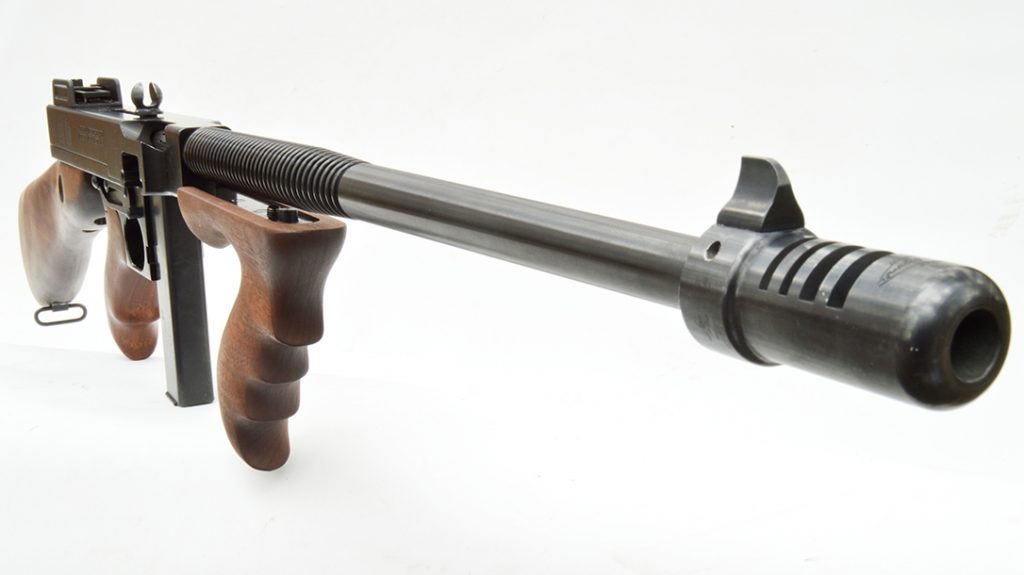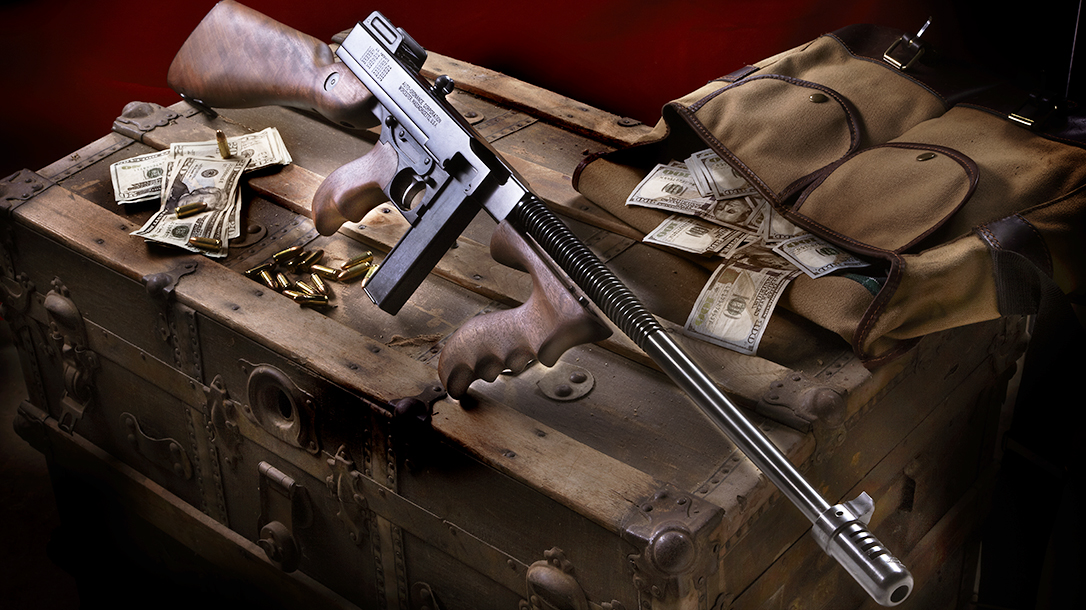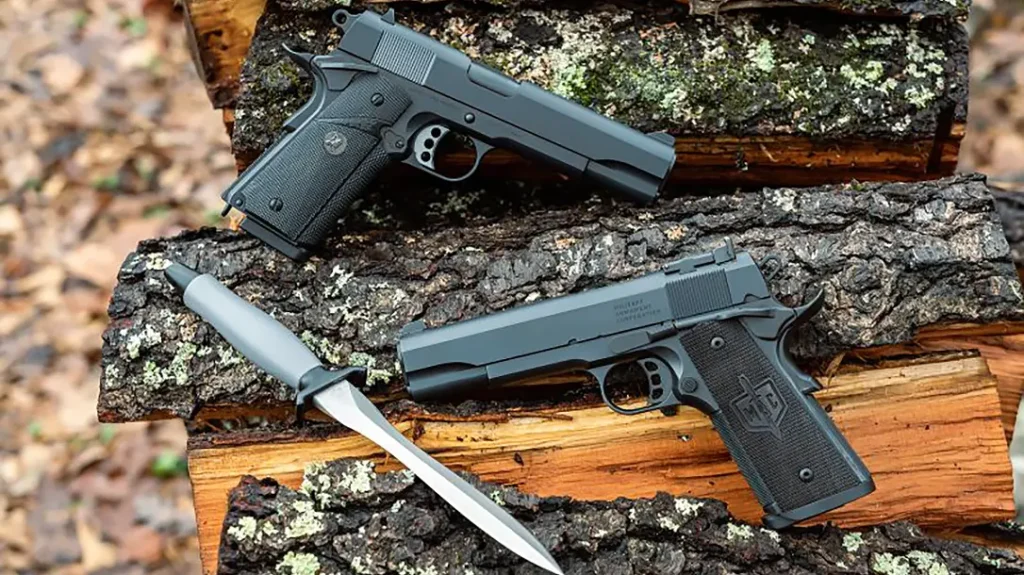After more than 90 years, the classic Tommy gun is finally available in 9mm. Externally, the only visual difference between the 9mm and .45 ACP versions, besides the caliber markings, is that the 9mm uses a slightly scaled-down magazine.
Otherwise, all the classic lines of this iconic firearm remain, but with a 16-inch barrel rather than the original 10-inch one. The longer barrel makes the Auto-Ordnance Tommy gun the same as any other long gun from a legal standpoint. Nothing special is needed to buy one over the counter at your favorite retailer other than the usual Form 4473 and a background check. On the other hand, if Auto-Ordnance made the Tommy gun with its original short barrel, the gun would be classified as a short- barreled rifle (SBR) requiring NFA registration and a $200 tax stamp. That’s a lot of extra time and money that could be spent at the range.
Converting the Auto-Ordnance Tommy gun to the lighter caliber wasn’t as simple as you might expect. The semi-auto varies significantly from the original full-auto version. The former fires from a closed bolt and the latter from an open bolt; a great deal of effort went into the semi-auto version to make sure it stayed that way.
Advertisement — Continue Reading Below
A mischievous tinkerer with a longing for a felony conviction might think that simply removing the trigger disconnector would turn it into a full-auto, but it won’t. For one thing, the weight of the internal parts and power of the springs were carefully balanced so they would only work in semi-auto, but there’s a lot more to it than that. This makes the imaginative engineering that went into the semi-auto Tommy gun all the more impressive.
The Auto-Ordnance 1927A-1C Tommy and M1 Carbine
Two 9mm models are available from Auto-Ordnance. The Auto-Ordnance 1927A-1C Lightweight Deluxe carbine has all the features of the gangster-era “Chicago Typewriter” — the top-mounted cocking handle, vertical foregrip, finned barrel, Cutts compensator, Lyman-style rear sight and slots in the magazine well to accept 50- and 100-round drum magazines.
The second version represents the simplified Thompson that was created to expedite production during World War II. Auto-Ordnance’s M1 Lightweight Carbine has the wartime straight forend, fixed-aperture rear sight in a heavy stamped-sheet-metal guard, and a side-mounted cocking handle. The M1 version has no Cutts compensator or frame slots for drum magazines. (The U.S. Army Ordnance Department stuck with stick magazines because they were easier and cheaper to manufacture.)
Advertisement — Continue Reading Below
A Closer Look
The bolts on these semi-autos lock back after the last round is fired. They have the same operational controls as the full-auto versions, but the rotating safety selector only has fire (forward) and safe (rearward) positions. The Auto-Ordnance 1927A-1C Lightweight Deluxe was made for right-handed shooters. The top cocking lever is as close as any of them ever got to ambidextrous controls. On the closed-bolt semi-auto, it takes an unexpected amount of pulling force (over 25 pounds) to cock the gun against the three coil springs inside—two for recoil and one to drive the cylindrical hammer home against the stamped-steel firing pin. The bolt handle doesn’t go back all the way in the slot, either.

These characteristics are common in semi-autos reengineered from full-auto designs. They may look exactly alike on the outside, but they work differently on the inside. It’s important to understand how these changes affect the manual of arms. In the case of this gun, never try to cock the bolt with the safety on, as you can damage the firing pin.
Advertisement — Continue Reading Below
The new Auto-Ordnance guns feature 6061-T6 aluminum upper and lower receivers that have been hardcoat anodized black—just like the company’s proven “Lightweight” .45 ACP models. Cosmetically, the sharp edges of the ejection port are more vulnerable to getting dinged and nicked, but that’s the tradeoff for shedding over a pound of weight, and it’s nothing a little dab of Birchwood Casey Aluminum Black wouldn’t touch up.
Personal Testing
I tested the 1927A-1C Lightweight Deluxe model and found the overall fit and finish to be top notch. In fact, I didn’t even notice the receivers were aluminum at first. The roll markings are beautifully done in an authentic style, from the block of patent dates on the rear of the receiver to the Thompson bullet logo on the pinned Cutts compensator. The wooden furniture is oil-finished American walnut. The buttstock on this model lacks the push-button quick-removal feature of the original. It’s technically a fixed buttstock. The sights aren’t adjustable for windage, but the ladder-style rear sight has an elevation-adjustable aperture; I used this in testing because I couldn’t focus on the open sight notch with my aging eyes. I prefer the aperture anyway.
At the range, the 9mm had a lot less recoil than its .45 ACP counterparts and was easier to control in rapid fire. At 50 yards, my groups were consistently about 1.25 inches to the left of my point of aim and strung out vertically. I realized the rear sight ladder has a tendency to tilt while firing, especially in rapid fire. It won’t cause you to miss a silhouette target at 50 yards, but you might miss a tin can.
Advertisement — Continue Reading Below
If you can’t tolerate fluctuating elevation, Auto-Ordnance sells an exact replica of the original elevation- and windage-adjustable Lyman rear sight for $280. It’s a masterpiece of precision made by Lyman. The company even installs it for a small fee. As of this writing, International Military Antiques (IMA) has vintage original military Lyman sights in excellent condition available on its website for $250 that go onto the modern Tommy guns with minimal fitting. I noticed that IMA also had reproduction five-cell magazine pouches for $25 and nice original ones for $35; that’s a great deal.
Range Impressions
The 9mm Tommy gun is great fun to shoot. However, despite having what is essentially a free-floating barrel, it’s not something you should expect fine accuracy from. The main culprit is the trigger. This is a closed-bolt semi-auto, but it still has the long, heavy and irregular trigger pull of an open-bolt submachine gun. The trigger pull on my test gun weighed between 7.5 and 8 pounds. Realistically, most people will never notice because the Tommy gun, even a semi-auto one, calls to you to fire it as fast as you can. It only comes with a single 20-round stick magazine, but Auto-Ordnance says it will likely make a 50-round drum for it, too.

Advertisement — Continue Reading Below
Also, it’s worth mentioning that Auto-Ordnance warns against shooting steel-cased ammunition through any of its semi-auto Tommy guns, or you’ll void the warranty. A lot of people love steel-cased ammo because it’s cheap, and this warning will be hard for some to heed. Without going into great detail, there’s a good reason for this warning, and it’s sound advice for any pistol-caliber carbine—especially one that people like to employ for rapid fire against tin cans downrange. For peace of mind, stick with quality brass-cased factory ammunition for pistol-caliber carbines.
I wouldn’t recommend reloaded ammo, either, because of the increased chance of a squib load. You wouldn’t want a bullet stopping halfway down that 16-inch barrel and going unnoticed in rapid fire. I’m not saying that you wouldn’t notice the reduced report and recoil, but somebody else might not. Like the .45 ACP models before them, the new 9mm additions to the Auto-Ordnance Tommy gun line are fun to shoot fast, so just make sure you do your part to protect your gun and yourself by using only factory loaded brass-cased ammo.
Final Thoughts
In the end, the Auto-Ordnance 1927A-1C Lightweight Deluxe was a lot of fun on the range. I definitely recommend trying it out for yourself. It’s got plenty of historic cache while being chambered in the affordable 9mm. What’s not to love? For more information, visit Auto-Ordnance.com.
Advertisement — Continue Reading Below
Auto-Ordnance 1927A-1C Lightweight Deluxe Specs
- Caliber: 9mm
- Barrel: 16.5 inches
- Overall Length: 41 inches
- Weight: 13 pounds (empty)
- Stock: American walnut
- Sights: Front blade, adjustable rear
- Action: Semi-auto
- Finish: Black
- Capacity: 20+1
- MSRP: $1,364
Auto-Ordnance 1927A-1C Lightweight Performance
| Load | Velocity | Accuracy |
| CCI Blazer Brass 115 FMJ | 1,273 | 3.26 |
| Federal American Eagle 124 FMJ | 1,182 | 3.29 |
| Winchester 115 FMJ | 1,127 | 2.95 |






















